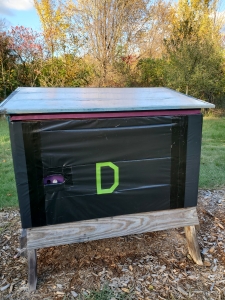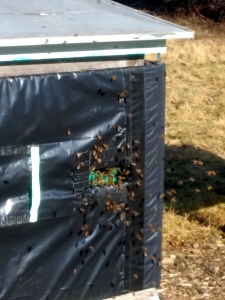Posted by theprospectofbees under
Uncategorized
[2] Comments
 Once again busier-than-usual life distracted us but this year we managed to neglect only our bee blog but not our bees. We monitored for mites regularly and treated as we saw need.
Once again busier-than-usual life distracted us but this year we managed to neglect only our bee blog but not our bees. We monitored for mites regularly and treated as we saw need.
Dorcas grew quite populous and ever kept her mite count low to nonexistent without our help, although we did treat her once when we first treated Clarissa. Bees can drift between hives and the mites may hitch a ride, perhaps to escape treatment fumes, so it can be good practice to treat all hives in a yard. Or, at least, the hives neighboring an ill one.
Meanwhile, Clarissa likewise grew but consistently lagged behind Dorcas in spite of our once transferring a frame of capped brood from Dorcas to Clarissa in an attempt to even out their populations. On the other hand she always had higher mite counts than Dorcas but never excessively large, just hovering about treatment threshold with the aid of formic acid and thymol. Both hives seemed in good shape last weekend when we winterized each hive thus:
 Removed frames that had not yet been drawn out.
Removed frames that had not yet been drawn out.
 Added two frames holding no-cook candy boards for humidity control and emergency rations.
Added two frames holding no-cook candy boards for humidity control and emergency rations.
 Applied an oxalic drip using Randy Oliver’s medium strength syrup recipe.
Applied an oxalic drip using Randy Oliver’s medium strength syrup recipe.
 Placed our black-plastic-wrapped, insulating panels around the hive.
Placed our black-plastic-wrapped, insulating panels around the hive.
And with that we settle into the usual winter worrying and waiting.
 Sorry for the poor quality of this picture of Clarissa, impulsively taken with a cheap phone. But, oh, the subject!
Sorry for the poor quality of this picture of Clarissa, impulsively taken with a cheap phone. But, oh, the subject!



